I'm starting a new project, so I figured I'd document my current setup. I haven't done any work on these in over a month, and the data is kinda scattered on my computer but I think I pulled together the relevant info.
These are active 4-way dipoles. I call them "Dipole Disorders" because of the impact my audio addiction has had on my life the last couple years 😀. It's been fun though. The drivers are: Neo3, Neo8, Vifa M21, and Eminence Delta LFA 15". I chose the B&Gs due to their equal front-back radiation and small size format. The Vifa's were stand-ins until I found something better........more on those later. The Emi's were a decent price and had the parameters I was looking for when I put the u-frames together a year ago. The upper 3-ways are hung by wire from a frame attached to the u-frame. The wire hangs on grommets slipped over the bolts in the top of the frame. I can't feel any vibration transfer in the upper 3-way drivers from the woofer. Good enough for me. The u-frames are made out of .5" chipboard, just meant to be prototypes. I never got around to making nice ones. The 15s are magnet mounted as well as mounted to the baffle.
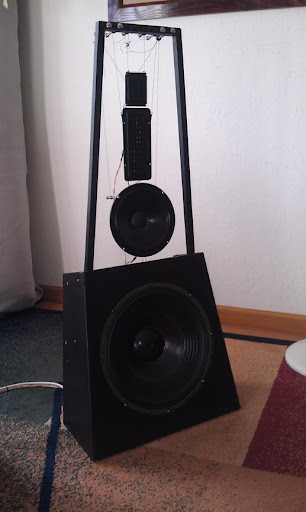

Crossovers at 250, 900, and 4000. I've played with different xo points but this is where I've settled. I wanted to get the widest bandwidth I could out of the Neo8s without disrupting the polar response too much. The filters themselves are a sort of elliptic-notch filter, with a LR4 roll-off then transitioning to an 8th order in the stop band. Tried various topologies here as well and this is what I'm happy with. Here's the individual eq'd driver responses on axis from about 60". The measurements were made with ARTA, but I haven't licensed it yet so I exported them to REW. Gating if I remember correctly was 3.5ms.
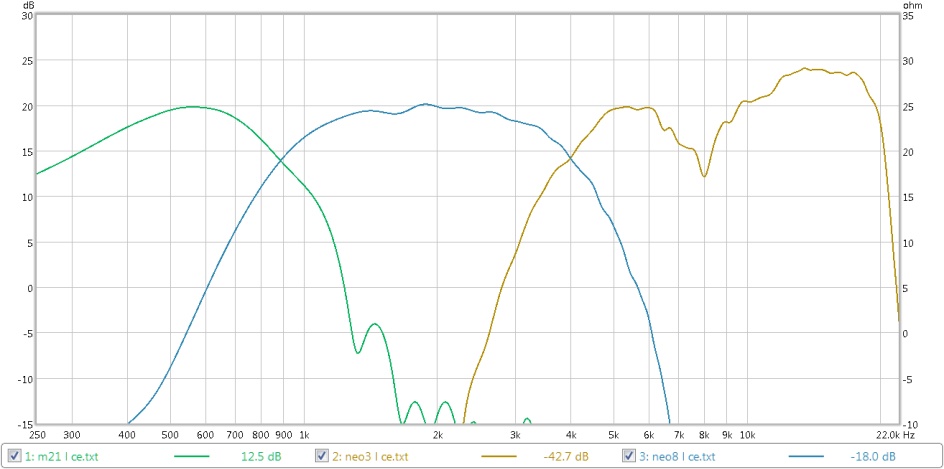
No eq driver measurements, starting with the Neo3:
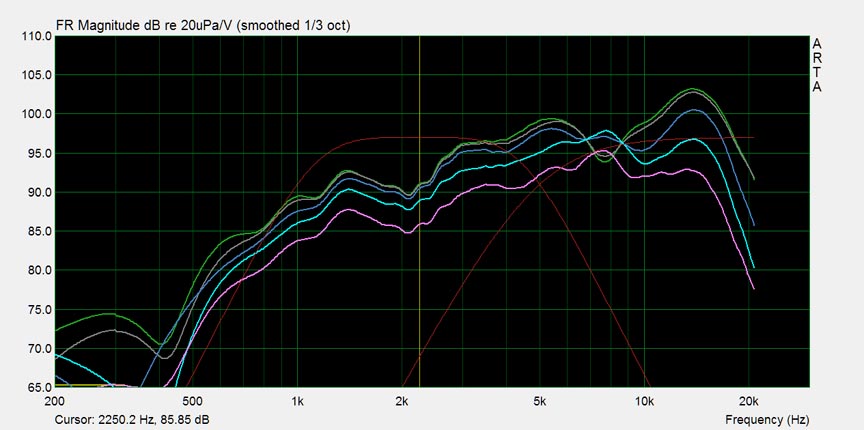
Neo8:

Vifa M21:
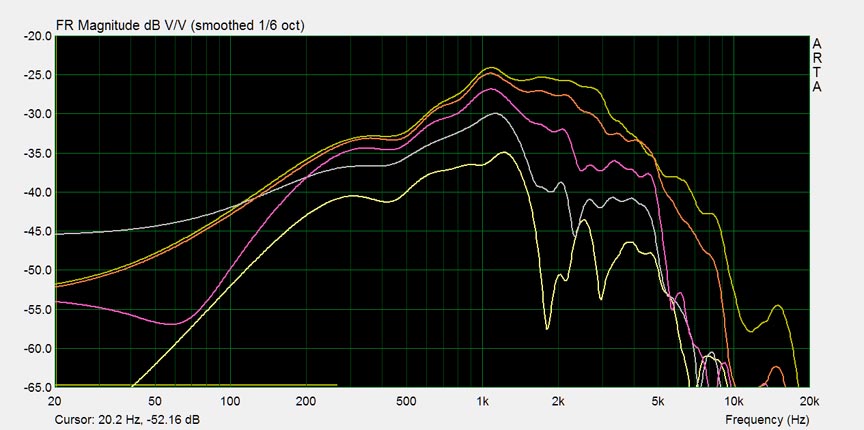
Delta 15 in u-frame:

I suppose I should state some design criteria, so this all makes a little sense 🙄. I've been playing with dipoles for a couple years, starting with an 8" FR over a cheap 15" woofer. Intrigued, I decided to go all out on an active 4-way system. My main goal is constant directivity through as wide a bandwidth I can get. I live in an apartment so high SPLs are not required, and the woofer's eq'd response down to 40hz is plenty. With the decision made to get CD, naked drivers seemed an elegant solution. Plus, I don't have a garage and a lot of tools so ease of construction is a bonus. Due to the unbaffled response of the drivers active xo/eq was a no brainer. I think it has its benefits as well. I decided on 4-ways because I wanted to use the Neo3s, but I don't like them below 2500hz. I wanted to cover roughly 1k-5k with one driver and this is the best I could do with my design constraints. Here's the polar response at 0,15,30,45, and 60 degrees (the green measurement in the middle is ARTA's calculated power response). I lifted the top octave on-axis to get a flat power response.
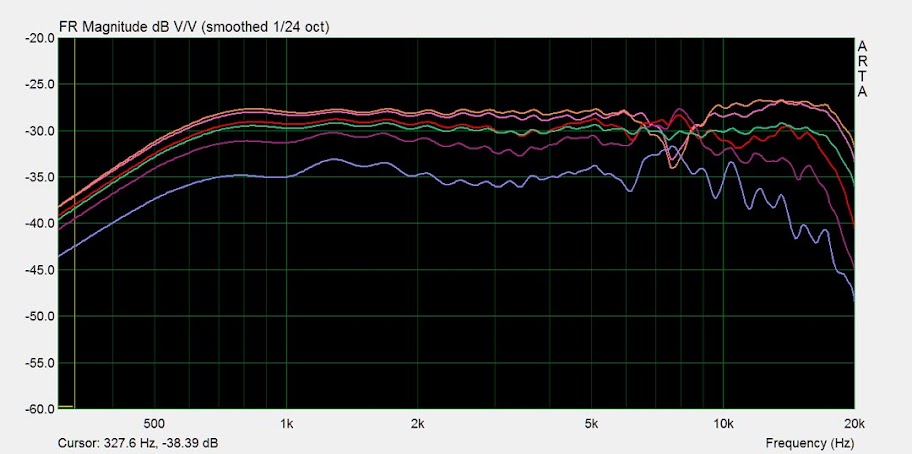
The Deltas were eq'd from about 10-12 measurements taken around the listening position. I also did a bit of selective DRC from the listening position, using the same method of 10-12 measurements around the lp. Here's the left and right averages after eq:

These are active 4-way dipoles. I call them "Dipole Disorders" because of the impact my audio addiction has had on my life the last couple years 😀. It's been fun though. The drivers are: Neo3, Neo8, Vifa M21, and Eminence Delta LFA 15". I chose the B&Gs due to their equal front-back radiation and small size format. The Vifa's were stand-ins until I found something better........more on those later. The Emi's were a decent price and had the parameters I was looking for when I put the u-frames together a year ago. The upper 3-ways are hung by wire from a frame attached to the u-frame. The wire hangs on grommets slipped over the bolts in the top of the frame. I can't feel any vibration transfer in the upper 3-way drivers from the woofer. Good enough for me. The u-frames are made out of .5" chipboard, just meant to be prototypes. I never got around to making nice ones. The 15s are magnet mounted as well as mounted to the baffle.


Crossovers at 250, 900, and 4000. I've played with different xo points but this is where I've settled. I wanted to get the widest bandwidth I could out of the Neo8s without disrupting the polar response too much. The filters themselves are a sort of elliptic-notch filter, with a LR4 roll-off then transitioning to an 8th order in the stop band. Tried various topologies here as well and this is what I'm happy with. Here's the individual eq'd driver responses on axis from about 60". The measurements were made with ARTA, but I haven't licensed it yet so I exported them to REW. Gating if I remember correctly was 3.5ms.

No eq driver measurements, starting with the Neo3:

Neo8:

Vifa M21:

Delta 15 in u-frame:

I suppose I should state some design criteria, so this all makes a little sense 🙄. I've been playing with dipoles for a couple years, starting with an 8" FR over a cheap 15" woofer. Intrigued, I decided to go all out on an active 4-way system. My main goal is constant directivity through as wide a bandwidth I can get. I live in an apartment so high SPLs are not required, and the woofer's eq'd response down to 40hz is plenty. With the decision made to get CD, naked drivers seemed an elegant solution. Plus, I don't have a garage and a lot of tools so ease of construction is a bonus. Due to the unbaffled response of the drivers active xo/eq was a no brainer. I think it has its benefits as well. I decided on 4-ways because I wanted to use the Neo3s, but I don't like them below 2500hz. I wanted to cover roughly 1k-5k with one driver and this is the best I could do with my design constraints. Here's the polar response at 0,15,30,45, and 60 degrees (the green measurement in the middle is ARTA's calculated power response). I lifted the top octave on-axis to get a flat power response.

The Deltas were eq'd from about 10-12 measurements taken around the listening position. I also did a bit of selective DRC from the listening position, using the same method of 10-12 measurements around the lp. Here's the left and right averages after eq:

Thank for all the nice info. Polars looks great except for the weirdness at 7-8KHz from the Neo3 which appears to be inherent in the driver, nothing you did.
What are you using for amplification? And volume control?
Greg
What are you using for amplification? And volume control?
Greg
Yeah the Neo3 is what it is, 1/2 wl cancellation due to its size in a nude dipole config.
Amps are nothing fancy. 200 watt Adcom on the bass drivers and a 6 channel job I put together with Sure tk2050 class d boards. It works. Crossovers and eq are done on my PC with J River Media Center, it also handles the volume control. DAC is an Echo AudioFire 12. I have attenuators on the amp inputs so I can set the gain structure and make use of the full bit-depth of the DAC, or at least close to it. I have a remote for the PC and J River processes the audio from all of my PC sources so it's pretty convenient.
Amps are nothing fancy. 200 watt Adcom on the bass drivers and a 6 channel job I put together with Sure tk2050 class d boards. It works. Crossovers and eq are done on my PC with J River Media Center, it also handles the volume control. DAC is an Echo AudioFire 12. I have attenuators on the amp inputs so I can set the gain structure and make use of the full bit-depth of the DAC, or at least close to it. I have a remote for the PC and J River processes the audio from all of my PC sources so it's pretty convenient.
You could get a more even response by crossing the Neo 8's and 3's at 10Khz. The almost square shape of the Neo 3 is causing the dip. The neo 8, being rectangular, should be much more linear in the 6-9khz range..
Last edited:
I had considered that, but the Neo8 has its' own dip at about 5.5k, though it's not as bad as the Neo3's. That, and it's beaming pretty well by 10k. Not to mention the ctc spacing issues crossing that high.
I'm pretty happy with the sound I'm getting. I toe them in so they cross about 1.5' in front of me. The power response evens things out pretty nicely as well.
I'm pretty happy with the sound I'm getting. I toe them in so they cross about 1.5' in front of me. The power response evens things out pretty nicely as well.
Member
Joined 2009
Are you familiar with this project? The answer to your problem could be somewhere in that thread.
http://www.diyaudio.com/forums/multi-way/175745-three-way-nude-swinging-dipole-thread.html
http://www.diyaudio.com/forums/multi-way/175745-three-way-nude-swinging-dipole-thread.html
Don't let people confuse you, who have never heard your system. This is my approach with the Neo3 and a Peerless HDS PPB 4-25/8, crossed in my case at 2 kHz:I had considered that, but the Neo8 has its' own dip at about 5.5k, though it's not as bad as the Neo3's. That, and it's beaming pretty well by 10k. Not to mention the ctc spacing issues crossing that high.
I'm pretty happy with the sound I'm getting. I toe them in so they cross about 1.5' in front of me. The power response evens things out pretty nicely as well.
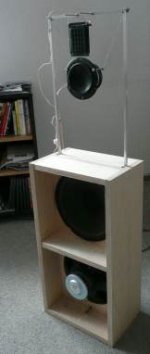
This is my way of suspension:
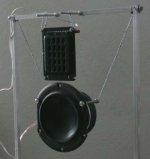
As you, I don't see or feel any influence of any H frame vibrations on the mid driver and tweeter.
When I would EQ my system exactly to a linear response at 30°, the sonogram would be this:
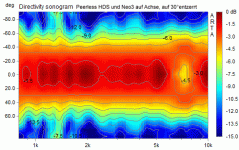
I believe this is an impressive compromise between "flat on design axis" and "flat in overall response". Your approach of flat power response should be almost identical to this.
Your room measurements indicate, how negligable the 7-8 kHz dip in the Neo3 response is for the actual listening experience. We both have heard it - others are just arguing. 🙄
Rudolf
Are you familiar with this project? The answer to your problem could be somewhere in that thread.
http://www.diyaudio.com/forums/multi-way/175745-three-way-nude-swinging-dipole-thread.html
I can't say that I feel I have a problem 😉
That thread was definitely inspiration for this project, as well as Rudolph's work
 . Glad to see you have Neo's Rudolph. I was wondering when you were gonna get rid of that little widebander and go with the planar.
. Glad to see you have Neo's Rudolph. I was wondering when you were gonna get rid of that little widebander and go with the planar.- Status
- Not open for further replies.
- Home
- Loudspeakers
- Multi-Way
- 4-way Dipolar Disorder........